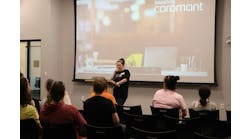Jim Montague is the executive editor for Control. Email him at [email protected].
I just finished my second science, technology, engineering and math (STEM) cover article this year, "Spring Chickens" for the September issue of our sister magazine, Control. It followed "Automation's Got Talent" in the July issue of Control Design.
One of the common revelations and themes running through both stories is that the most useful STEM programs at community colleges, high schools and elementary schools get help from the very same engineering and technology companies that eventually will hire their graduates. Despite old stereotypes to the contrary, it turns out that engineers, technicians and operators are best at instilling the problem-solving and technical skills that young people will need to enter those professions.
The remaining challenge is how to bring engineers and other technical professionals into their local schools. The cover stories have several examples of machine builders and process automation companies reaching out to their community colleges, forming longstanding partnerships, developing targeted curricula, and even going into the classrooms to teach students directly about automation processes and how to control them. But how are these partnerships formed?
Also Read: The Kids Are All Right: Producing Rookie Engineers From STEM Programs
Well, beyond simply making a few phone calls and sending a few emails, cooperating with local colleges and schools on STEM education mostly requires basic participation. This is similar to the old saying that the biggest ingredient for success in politics is simply showing up. This is not too complicated, but it really requires some extra initiative.
"We're always looking for new talent, and so we maintain an active role with our local universities to help us get noticed," says Tony Paine, CEO at Kepware Technologies. "We've had a lot of success with the University of Maine at Orono, which has an Electrical Computer Engineering Advisory Council to make sure its programs produce graduates that industry deems worthy of hiring. The council has been around for 20 years, and I've been on it for five years. We look at curricula, where faculty members spend their time, and we talk with students too.
"This is especially important because our biggest problem is getting students interested in engineering, keeping up their interests and staying with it even when problems arise due to all the required math and physics. A big topic for engineering is low retention rates because even if brilliant students love these topics, they often don't know how they're applied. This is where working engineers and technicians can really help because students are a lot more willing to stick with their education if they know what the end game can be."
To help students get some real-world experience, Kepware offers three or four paid internships per summer, and Paine reports the interns have helped it solve some difficult problems. For example, Kepware's software, OPC servers and other solutions typically communicate with PLCs, which requires entering tag data to collect information, building databases or obtaining entire tag databases from files. "Two summers ago, we sought to develop a little software script for generating tag addresses based on templates, and our students helped us come up with the design, development and documents for our Advanced Tag Dialog user interface that can configure up to 30,000 tags rapidly. Later, they downloaded versions to show their classmates what they'd been working on, and this generated a lot more interest from other students that wanted to intern with us too."
Paine adds that spending just a little time with students can help machine builders, system integrators, suppliers and other manufacturers gain students' awareness, interest and trust, and provides the youngsters with some much-needed direction in the extremely varied world of engineering and the industries it serves. "We want to get our message out, but manufacturing is very broad, and students need focus," Paine adds. "Twenty years ago, technology wasn't changing as fast as it does now. Today, the engineering curriculum at Orono includes hardware applications using C software, Ethernet and RS232 networking, USB ports and small-board programming environments like Arduino and Raspberry Pi. However, the students also need to take communication classes, so they can write, speak publicly, manage projects and collaborate among themselves and across disciplines. STEM and other programs help students get some real exposure, identify the path that's right for them and learn how to get there. We can help it happen."





